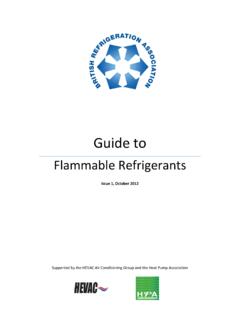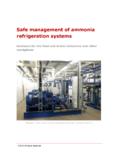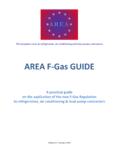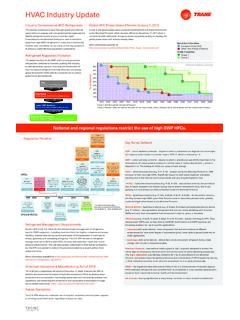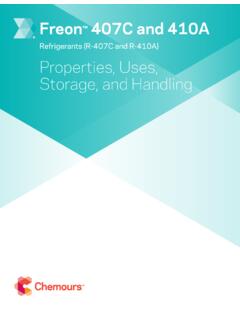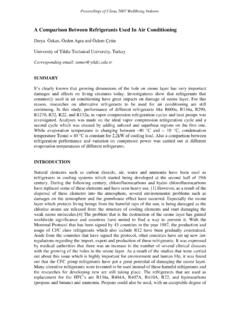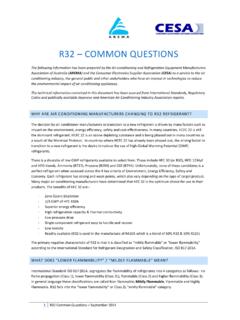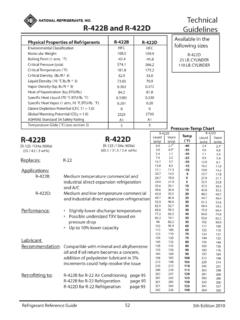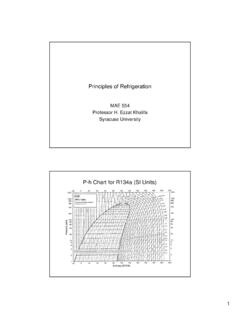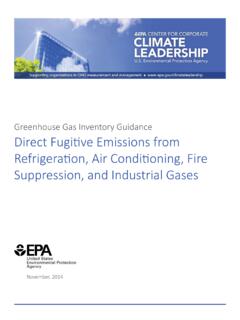Transcription of An Introduction to A2L Refrigerants - Refcom
1 An Introduction to A2L Refrigerants and their use in Refrigeration, Air Conditioning and Heat Pump applications OVERVIEW The 2015 F-gas regulation is driving industry to use lower GWP1 Refrigerants in many applications. The EU regulation (517/2014), which came into force on the 1st January 2015, introduces a ban on new equipment using HFC Refrigerants with a GWP of over 2500 by 2020. The regulation also introduces a phase down, related to GWP and measured in CO2 equivalent tonnes, which will drive industry to use lower GWP options. As a result, a new family of Refrigerants both pure fluids and blends has been (and continues to be) developed - these are Hydro Fluoro Olefins (HFO). A feature of many of these products (and some existing Refrigerants such as R32 and Ammonia) is that they exhibit lower flammability2, and hence a new classification has been introduced by ASHRAE3 to cover this feature A2L. (In the case of Ammonia the classification is B2L, due to its toxicity) This guidance note has been written by members of FETA Associations to give an overview of these new Refrigerants , and some basic advice as to their use in the field.
2 REGULATORY BACKGROUND ISO4 and IEC5 standards are international safety in use type standards. European Norms or EN standards are typically based on an international standard. The relationship between International and European Union standards is highlighted in the table below. 1 Global Warming Potential 2 A2L Refrigerants are commonly referred to as mildly flammable . This guide uses lower flammability to be consistent with standards phraseology 3 American Society of Heating, Refrigerating and Air Conditioning Engineers 4 International Standards Organisation 5 International Electrotechnical Commission The graphic below shows the interaction between the various standards noted above, and EN378 in particular, which is the primary standard that designers and installers use when considering the safety and design limitations of a system. [CEN European Committee for Standardisation] [CENELEC European Committee for Electrotechnical Standardisation] Standards and regulations are constantly evolving, and future changes will enable the industry to make use of the new family of A2L Refrigerants more extensively.
3 It should be noted, however, that the A2L classification is only used in reference to refrigeration, air conditioning and heat pump system safety, and is used by standards such as EN378 and ISO 5149 to determine maximum allowable charge size, etc. It IS NOT recognised by transport regulations (ADR6) and is not a recognised classification on Material Safety Data Sheets (MSDS). GHS7 is the agreed international standard in this instance. When A2L products are stored and transported, they are classified as an extremely flammable gas, much the same as acetylene and MAP gas, commonly used by the industry for brazing. The exception to this is HFO R-1234ze (E), which GHS classifies as non-flammable (at 20 deg C). There should be no significant changes required to vehicles that transport A2L Refrigerants , but there should be some form of ventilation and signage to inform authorities if there is an accident. Storage on site and at installer s premises should also comply with ADR and MSDS rules.
4 6 International Carriage of Dangerous Goods by Road 7 Global Harmonised System of Classification and Labelling of Chemicals Currently, the HSE8 in the UK does not recognise the A2L classification and views these products as highly flammable. Hence, safety guidance will also need to be reviewed for installations containing A2L Refrigerants using DSEAR9 in the UK, and ATEX10 guidance in Europe. This requires a risk assessment to be undertaken, reviewing the application, location of components, and the installed refrigerant charge. In these circumstances, installation guidelines can form the framework for such risk assessments. By choosing the right refrigerant , equipment and location as dictated by EN378 the probability of forming a flammable atmosphere can be eliminated, making this assessment potentially very straightforward as many manufacturers are including data to carryout risk assessments within their technical documentation.
5 CURRENT Refrigerants Refrigerants are classified as below: The vast majority of HFC and HFC/HFO blend Refrigerants in current use are classified as A1, with low toxicity and zero flammability. Ammonia, which has been in use for many years, is classified as B2L; R-152a is an A2 refrigerant , and all hydrocarbons are classified as A3. It is vital to understand what Refrigerants are in your system, and to make sure that the system complies with the requirements for leak checking and the phase down schedule of your particular gas. All Refrigerants in the table below are A1. 8 Health and Safety Executive 9 Dangerous Substances and Explosive Atmospheres Regulation 10 ATmosphere EXplosibles (French) A3 B3 Higher Flammability A2 B2 Flammable A2L B2L Lower Flammability A1 B1 Non-Flammable Lower Toxicity Higher Toxicity ISO 817 refrigerant Classification Scheme List of Common Refrigerants refrigerant GWP11 Comments Suggested Action HFC R-407C 1774 AC/HP most DX systems using this refrigerant are now several years old so having a replacement plan would be advisable.
6 Some chiller manufactures are still using this refrigerant in new equipment so check that this is the best refrigerant to use for your application. HFC R-407A/F 2107/1825 These Refrigerants are being used in commercial refrigeration as an interim replacement for systems currently using R404A New equipment should not be installed using R-404A/507 HFO/HFC R-448A/ 449A ~1400 These Refrigerants are now being used in commercial refrigeration as a longer term replacement for systems currently using R404A/R507 New equipment should not be installed using R-404A/507. Plan to retrofit existing equipment with R448A/R449A HFC R-410A 2088 This refrigerant is predominately used in DX equipment in the A/C industry. Ensure that when using R410A that the correct F-Gas checks are in place. If installing small systems, try to use equipment manufacturer recommended low GWP alternatives where possible. HFC R-404A 3922 This refrigerant will be banned in most new equipment and for service use from 2020 Plan to replace this gas as soon as possible using either R407A/F, or one of the lower GWP HFO blends such as R448A, R449A or R452A.
7 HFC R-134a 1430 This refrigerant has applications in A/C and refrigeration. It has a medium GWP and availability is likely to be effected in the later stages of the phase down. This gas can continue to be used for the time being, but it is sensible to review the alternatives available. HFO/HFC R-452A 2141 This refrigerant is now being used in transport and small commercial refrigeration as a longer term replacement for systems currently using R404A/R507 New equipment should not be installed using R-404A/507. HFO/HFC R-513A/ R-450A These Refrigerants are now being used in commercial refrigeration and AC as a longer term replacement for systems currently using R134a 11 Taken from the IPCC 4 assessment as recognised in the F-Gas regulation List of A2L Refrigerants (those in bold are in current use; the others are beginning to appear on the market) refrigerant Other names GWP Applications R-1234yf 4 Automotive A/C R-1234ze 6 Chillers, Aerosol Propellant R-32 675 R-410A replacement R-454A XL40 238 R-404A replacement R-454C XL20 146 R-404A replacement R-455A L40X 145 R-404A replacement R-447A L41 >500 R-410A replacement R-452B XL55 676 R-410A replacement R-454B XL41 467 R-410A replacement WHAT DOES THE A2L CLASSIFICATION MEAN?
8 The main differences between A1 Refrigerants , such as R-410A, R-134a, R-407C, and A2L Refrigerants such as R-32, HFO R-1234yf and HFO R-1234ze is the ability to propagate a flame. A2L Refrigerants will burn, but their burning velocity is below 10cm/s, which is lower than an A3 refrigerant such as R-290 which actually burn explosively when ignited; hence the new classification. In practical terms, it is very difficult to ignite 2L gases, but some precautions must be taken to prevent accidental build-up of refrigerant , particularly during charging of systems. Manufacturers are suggesting that extract fans be used during this process, especially if the outdoor unit is in an enclosed area All flammable Refrigerants (class 2L and above) will not ignite if the concentration level in a room stays below their lower flammability limit (LFL). International and European safety legislation and standards such as ISO 5149 and EN 378 define requirements to remain far below the lower flammable limit in case of accidental leakage.
9 USE OF A2L Refrigerants IT IS VITAL TO UNDERSTAND THAT A2L Refrigerants MUST ONLY BE USED IN SYSTEMS DESIGNED SPECIFICALLY TO TAKE INTO ACCOUNT THEIR FLAMMABILITY CHARACTERISTICS. THEY SHOULD NEVER BE USED TO REPLACE NON-FLAMMABLE Refrigerants IN RETROFIT SITUATIONS without a full risk assessment and necessary modifications. This is because of safety issues and the possibility of a relatively large charge of an A2L being released by accident into an area that has not been risk assessed for use with this class of Refrigerants . Due to their lower flammability, A2L Refrigerants are intended for use in equipment specifically designed for these products and should always be used in accordance with the relevant national and international standards. Please consult the appropriate equipment manufacturer regarding which Refrigerants can be used in the equipment APPLICATIONS A2L Refrigerants are already in use in a variety of applications. From 1st January 2017, all NEW cars produced in Europe must contain a refrigerant with a GWP of less than 150 in their A/C system.
10 The product of choice is HFO R-1234yf. There are currently over cars on European roads that use this refrigerant , and this is expected to rise to 29m by the end of 2017. The automotive industry carried out exhaustive tests and risk assessments before using R-1234yf, and found it to present no more risk than its predecessor, R-134a. Manufacturers are well versed in the use of this refrigerant on production lines, although it does require those servicing cars to be aware of the differences. R-32 (an HFC classified as A2L) is now being widely marketed as an alternative to R-410A in new air conditioning systems, due to its similarity in performance to R-410A. There are well over 4m systems operating on R-32 in Japan although it should be noted that their regulations on the use of flammable Refrigerants are different to Europe. Some large chillers are now using R-1234ze as an alternative to R-134a. R-1234ze is an HFO and is classified as A2L, but, as previously noted, it is actually non-flammable at temperatures below 300C.
